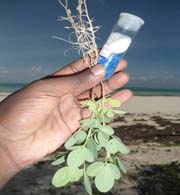Bio-prospecting for rhizobia is an important component within the work plans of Objective 3 researchers, but one that is open to innovative approaches. This activity (3.2) requires that a rhizobium germplasm bank be established and characterized in order to document the biodiversity of rhizobia in Africa and a culture collection maintained among multiple laboratories as a future genetic resource. Ironically, the term “bio-prospecting” does not appear in the original project document and it was first envisaged that we simply collect nodules from non-inoculated plots of agronomic experiments as the only source of the required 2000 isolates. This task was to have been completed by the First Quarter of Year 2 but was delayed owing to the need to better develop cooperator’s laboratories. The recent 18 month project report states that 340 isolates have been cultured from 17 legume host genera, leaving this task overdue and only 17% completed. Most of these isolates were obtained by the East and Central African (ECA) Hub and some valuable lessons were learned in the process. While collecting nodules from non-inoculated field experiments is valid, so too is collecting from natural legume communities, particularly from hosts belonging to the same genera or tribe. Another approach is to collect nodules from hosts growing in stressful environments. For example, in Kenya we organize sampling campaigns by agro-ecological zones and have isolated from tidal mud flats and sand dunes, acid soils and extreme elevations as a means of sourcing tolerance to salt, low fertility and low temperatures, respectively. It is more productive to sample seedlings in the understorey of perennial legumes and, in the case of seasonal re-sprouting perennials, it is extremely difficult to recover nodules unless the uppermost lateral roots are exposed and carefully uprooted. Experience suggests that the best place to source hosts and nodules is within semi-cultivated wetland margins as this niche supports a diverse array of cultivated and wild legumes that are nodulated throughout the year and these nodules occur close to the soil surface owing to a high water table. When sampling in drainage ditches, one should be particularly wary of snakes. Local farmers often show interest in nodule collection and may volunteer their assistance and crop plants, and care should be taken to explain the role of root nodules to them in return. Guidelines for rhizobial bio-prospecting were developed for the ECA Rhizobiology Training Course and are available from the Project Leader to others upon request. One urgent need in this area is the development of a project-wide system of labelling and cataloguing rhizobia isolates that both brands N2Africa but also provides recognition to countries and laboratories contributing to the culture collection. Now that the laboratories have been upgraded, isolating and characterizing rhizobia remains an important overdue activity by project scientists during Year 3.
 |
Nodule recovery from wild Vigna sp. growing in a sand dune of coastal Kenya. |
Paul Woomer
